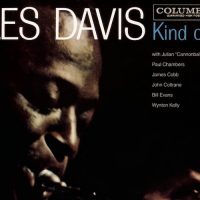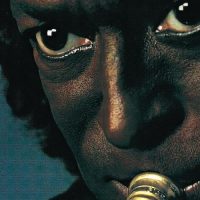The text below is a word-for-word replication of my January 23, 2009 review of Miles Davis’ Kind Of Blue, Legacy Edition album. Blue, which is Mostly Other People Do The Killing’s note-for-note replication of the original version Kind Of Blue, is due out October 14, 2014 on Hot Cup Records.
Miles Davis’ Kind Of Blue is widely proclaimed to be the best jazz album of all time. To me, such a declaration seems to downplay so many other jazz records that are phenomenal and hugely influential in their own ways. If I were able to take only one Miles album–much less any jazz album—to that mythical desert island, I’d probably even go with this one instead.
Maybe it’s more pertinent to ask: which jazz album should be the cornerstone of any jazz record collection?
Such a jazz album should have a cool, confident swagger: “So What”
Such a jazz album should swing: “Freddie Freeloader”
Such a jazz album should have a whimsical, emotional quality to it: “Blue In Green”
Such a jazz album should maintain a reverence for the blues: “All Blues”
Such a jazz album should incorporate exotic flavors: “Flamenco Sketches”
And most of all, a cornerstone jazz album should be performed by musicians who have the wherewithal, creativity and commitment to render all of the above: Miles Davis (trumpet), Cannonball Adderley (alto sax), Paul Chambers (bass), Jimmy Cobb (drums), John Coltrane (tenor sax), Bill Evans (piano) and Wynton Kelly (piano)…every one of these legends at or near their towering peaks.
However, Kind Of Blue incorporates all these attributes because of its reverence to great jazz of the past: the pioneering, improvising nature of Armstrong; the elegance and sophistication of Ellington; the modernist harmonics of Parker; and the reserved cool of Miles’ own music that he introduced a decade earlier. By using these building blocks, a new form of jazz was forged; one where the songs and solos are built around an overarching key, not the chord changes. That form became known as modal jazz, which would dominate much of the jazz in the sixties and remains a major part of the overall genre today.
These historic sessions, recorded on March 2 and April 22 of 1959, are now approaching a milestone birthday. In conjunction with the 50th anniversary of the Kind Of Blue sessions, the Sony imprint Columbia/Legacy this past Tuesday released a special, 2 CD edition of this album.
[SOMETHING ELSE! INTERVIEW: Jazz legend Jimmy Cobb recalls his spur-of-the-moment decision to join the Miles Davis band, and signature moments with Wes Montgomery and Dinah Washington.]
Originally released in the summer of 1959, Columbia and later Sony had re-issued this classic many times and in many forms. Just this past September, Sony had introduced a “super-deluxe” 12-inch box set containing the originally released five tracks, various, brief “studio sequence” tracks, and the only alternate take from the sessions, that of “Flamenco Sketches.” Furthermore, that box set came with a second CD, which contained the only other five studio recordings of Miles with his Evans-Coltrane-Adderley-Chambers-Cobb sextet. This same configuration would go on and wow concert-goers at the 1958 Newport Jazz Festival just three months later. The final track is a live version of “So What” taped live in 1960 without Evans and Adderley but with the addition of Kelly.
That box set also comes with a 60 page bound book that’s filled with exclusive photos, complete discographical annotation and essays reflecting on the recordings by a couple of noted authorities on Miles. All contained in a 12-inch slipcase box.
If that sounds like a bit much for you (and at $70 on Amazon.com, it most likely will), the Legacy Edition strikes the perfect compromise. You won’t get the 12″ box or the fancy book but there remains both discs with the same tracks and an attractive CD booklet filled with rare pictures and well-written liner notes. All for the coin of what many regular release CD’s go for.
The most significant of all these enhancements is that second CD, though. While those five additional studio tracks and the one live cut have been released before, to get them in its logical chronology and juxtaposed with the original Kind Of Blue tracks, you previously had to spring for expensive box sets like that aforementioned $70 set. These bonus tracks give the original album more context by providing a window into where this band stood in its rapid development leading up to and immediately following the watershed recordings.
The five 1958 studio recordings were performed just a couple of months after the sessions that produced the fine transitional Milestones, but the replacement of Red Garland and Philly Joe Jones with Evans and Cobb, respectively, had already moved the band down the path that would lead to Kind Of Blue. Even as the adherence to improvising within the melody remained the order of the day, the hot, urgent playing found on much of Milestones cooled down considerably. “On Green Dolphin Street” sets an understated, lean mood that would soon predominate Davis’ music until the mid-1960s. The other three songs, including two takes of “Fran-Dance,” would also represent softer tones that were not yet quite down to the extremely mellow mood of Blue, but the band was on their way there.
By contrast, the April, 1960 live recording of “So What” was rendered with a quickened tempo. By the following year, Coltrane as a leader would heat up this tune to the point that it became a new song, re-christened as “Impressions,” and became a launching pad for some of his most fiery solos.
There’s so much that can be said of Miles Davis’ Kind Of Blue that a mere review can’t begin to describe its significance. I will usually delve into individual performances on jazz records, but in this case, that’s a whole ‘nother discussion. Besides, while it may be an empty cliché to say about other records, here it really is best just to listen for yourself. One can write a book or essay on this one record and in fact, many have. The Legacy Edition itself contains a 2,500 word essay adorned with additional photos, all contained on a pdf file within Disc 1.
That’s all fine and good, but ultimately—as Miles himself would surely concur—such talk is cheap. The music is where everything that needs to be said is said. Kind Of Blue speaks a whole encyclopedia set of what jazz is truly about.
- Nick Millevoi – ‘Moon Pulses’ (2024) - April 23, 2024
- Cannonball Adderley – ‘Poppin’ in Paris: Live at L’Olympia 1972′ (2024) - April 20, 2024
- Christian Marien Quartett – ‘How Long Is Now’ (2024) - April 18, 2024




